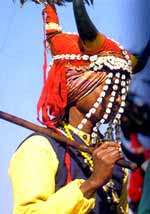|
Tribes
 The major tribes of Madhya Pradesh are
Gonds, Bhils, Oraons, Korkens, and Kols. The
tribal culture of Madhya Pradesh is mixed with traces of the Dravidians, the
Mundas and the Scythians. There are forest-dwellers such as the Abujhmarias, the hunters and the
gawkier such as the Korwas and the Pandhis. There are the Khaiwars and the Panikas who depend on indigenous
methods of cultivation. There are even many others whose profession is
singing and dancing such as the Mangetri Pradhans or the Nagachis or Bediyas.
The major tribes of Madhya Pradesh are
Gonds, Bhils, Oraons, Korkens, and Kols. The
tribal culture of Madhya Pradesh is mixed with traces of the Dravidians, the
Mundas and the Scythians. There are forest-dwellers such as the Abujhmarias, the hunters and the
gawkier such as the Korwas and the Pandhis. There are the Khaiwars and the Panikas who depend on indigenous
methods of cultivation. There are even many others whose profession is
singing and dancing such as the Mangetri Pradhans or the Nagachis or Bediyas.
The state presents in all a varied matrix of tribal culture ranging from
animists and fowlers to advanced cultivators and factory workers.
The
Chhatlisgarh region of the state comprises Raigarh, Surgaja, Bilaspur, Durg and
Raipur districts. It is found that the inhabitants of this area bestowed
with many peculiarities. The 'Pradhans', the hereditary chroniclers are a
bardic tribe of Chhatlisgarh and worship various Gods and Goddesses. The
Gond rulers patronized them in the fourteenth century. The
dialect spoken in the region is Chhatlisgarh. The soil is red and yellow
and almost half of the area comes under rice cultivation.
The
Indravati flows through the Bastar region and quite a large portion of this vast
district is covered with jungle. The Murias of North Bastar are
associated with institution of Ghotul which is a sort of dormitory for the young
boys and girls of this tribe. The bison-horn Marias or the sing-Marias
are settled to the south of the Indravati. They have very little
communication with the Murias of the north. The Raja Murias or
the Jagdalpur Murias consider themselves superior to other tribes. The
Halbas are the near Hindu caste predominant all over the tract. Halbi which is their dialect had great impact over other dialects spoken in the
region.
The wild and more primitive interior of Bastar is the rugged and
mountainous terrain of Abujhmar in the west of Narayanpur Tehsil.
The inhabitants here may eat any thing they like. Red ants is their
favourite dish. Rats are eaten with pleasure and to full satisfaction.
The
Abujhmarias have a strange wild appeal in their look as compared to the Murias
of the plains. Women are generally seen bare-bosomed and men roam
around wearing just a loin cloth. Only during festivals they add some
more items to their dress. Boys don all kinds of finery. They wear
red or white 'pagas' (turbans) with feathers tucked in their folds. The Hill
Marias believe in slash and burn type of cultivation. Many places of
Abujhmar are noted as un-surveyed. These areas are topographically rough
and dense with a variety of living things.
The
Dhurwas (Parjas) are the third largest Adivasi group in Baster following
the Marias and the Murias. The tribe is concentrated in Dantewara
and Konta. They border on most tehsils of Madhya Pradesh in the
South.
The
Bhils inhabit the districts of Dhar, Ratlam and Jhabua. A number of
beliefs and superstitions admit them 'outside the Hindu social system'.
The Bhil group constitutes the Bhilala, the Mankar, the Patlia, the Barela, the
Nihal or Naik and the Rathia.
The
Gond and Kol groups are found in Chhindwara. They are also settled by the
rivers of Betul, among the hills of Seoni and Balaghat. They have an
extensive legendary history of their past heroes. Tribals of Bastar
come under this group. The Gonds are a great people with stirring memories
and passionate poetry. They seem to have entered the wilds of Baster along
the banks of the Godavari. In the fourteenth century they were the ruling
class in many parts of central India. They built palaces, forts, tanks and
lakes but owing to their over-simplicity and tolerance they failed to retain
their establishments. Towards the end of the eighteenth century they were
found scattered into many tribes.
The
Baigas are a class of priests among the Gonds. They are the people who
know all about evil spirits and can avoid them by performing magical rites.
In Mandla district there is a small tract called Baiga Chak, known for its
Baiga settlement. The Baigas have now changed considerably.
The Pradhans are the musicians of the Gond and the
Baigas. If a Baiga is
not available to a Gond, a Pradhan is called for performing the rites. The
Korkus are confined to a small portion in the Narmada valley. Some of them
have taken to work in the coal-mines around Chhindwara.
The
Savaras are mostly inhabited in Sheopur (Morena district), Isagarh, Narval (Gwalior district) and
Bhilsa. This group also combines Saharia and
Sour. Among other tribes are the Kols of Maikal hills who are
mainly agriculturists and wage-earners in factories, the Korwas and the Oraons
of Raigarh and Surguja districts, the Bharias of Patalkot and the
adjoining areas in Chhindwara and the Binjhwars of Bilaspur.
The Banjaras are nomadic people settled in some parts of the Narmada valley.
They have a rich folklore of their own and a strong community sense.
|

